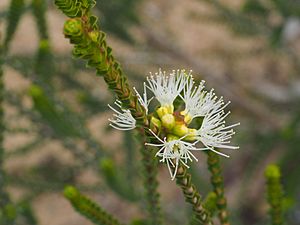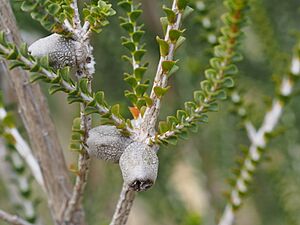Beaufortia sprengelioides facts for kids
Quick facts for kids Beaufortia sprengelioides |
|
|---|---|
 |
|
| B. sprengelioides in Kings Park, Perth | |
| Scientific classification | |
| Genus: |
Beaufortia (plant)
|
| Species: |
sprengelioides
|
| Synonyms | |
|
Melaleuca sprengelioides DC. |
|
Beaufortia sprengelioides is a cool plant from the Myrtaceae family, also known as the myrtle family. It only grows in the south-western part of Western Australia. This plant is a tough, spreading bush with lots of round leaves. It has small, round clusters of light pink flowers at the end of its branches. Beaufortia sprengelioides was one of the first Australian plants that Europeans collected. Its name has changed a few times since then!
Contents
What Does Beaufortia sprengelioides Look Like?
Beaufortia sprengelioides is a strong, spreading bush. It can grow up to about 2 meters (6.5 feet) tall. Its leaves are packed closely together. They are mostly arranged in opposite pairs, making four neat rows along the stems. This is especially true on the younger branches.
The leaves are flat or slightly curved like a dish. They are broad and round, about 2 to 3 millimeters (0.08 to 0.12 inches) long. Each leaf has three main veins, plus tiny ones along the edges.
Flowers and Fruit
The flowers are light pink to white. They grow in round clusters at the ends of the branches. These branches keep growing even after the flowers bloom. Each flower has 5 sepals (small leaf-like parts), 5 petals, and 5 groups of stamens. Stamens are the parts that produce pollen.
The groups of stamens give the flowers their pretty color. Each group has 9 to 15 stamens. They are joined together for more than half their length. This plant blooms from July to November. After flowering, it produces woody fruits called capsules.
How Did It Get Its Name?
Beaufortia sprengelioides was first collected a very long time ago, before 1670. An English explorer named William Dampier found it.
The plant was officially described in 1828 by a Swiss botanist named Augustin Pyramus de Candolle. He first called it Melaleuca sprengelioides. Later, in 1999, Lyndley Craven gave the plant its current name, Beaufortia sprengelioides.
The second part of its name, "sprengelioides," means it looks like plants from the Sprengelia genus. The ending "-oides" comes from an Ancient Greek word meaning "form" or "likeness."
Where Does Beaufortia sprengelioides Grow?
You can mostly find Beaufortia sprengelioides growing between Eneabba and Shark Bay in Western Australia. It also grows on some islands near the coast.
It likes to grow in sandy soil, often near limestone. You can find it on sand dunes and flat plains.
Is It Endangered?
The Western Australian government's Department of Parks and Wildlife says that Beaufortia sprengelioides is "not threatened." This means there are enough of these plants, and they are not in danger of disappearing.


